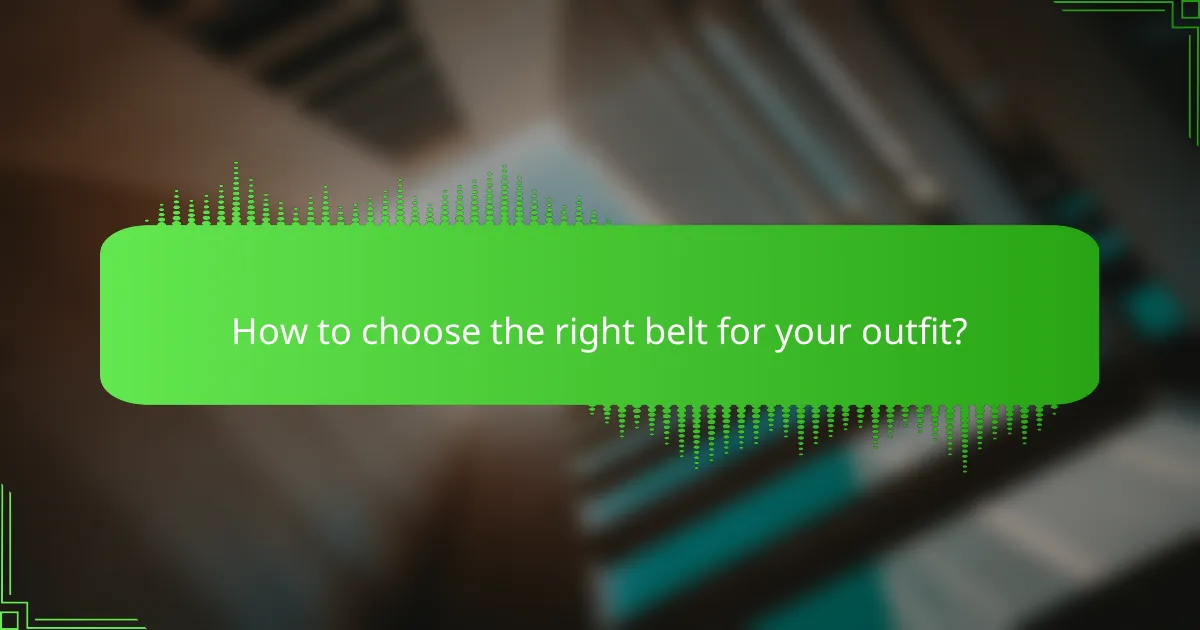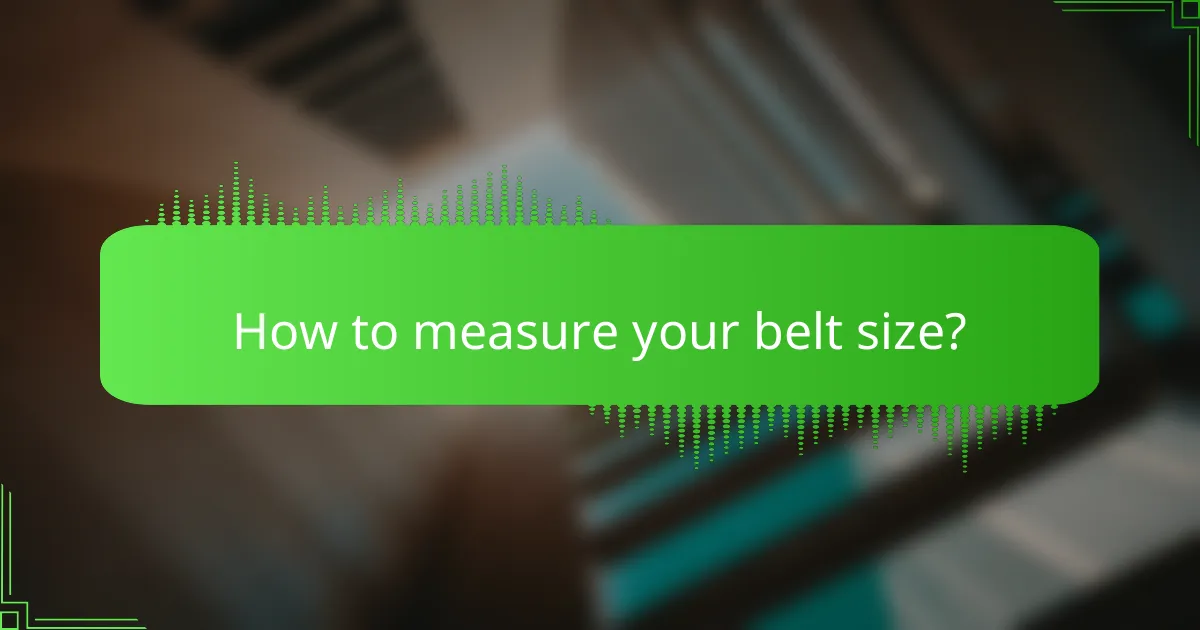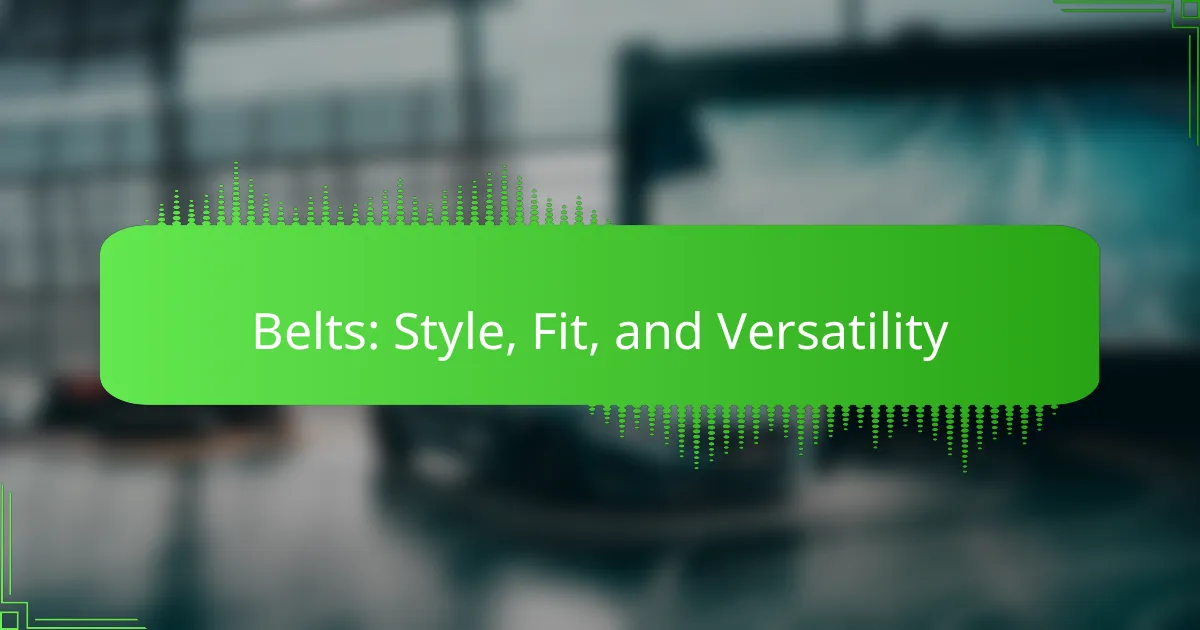Belt selection is crucial for achieving a polished and cohesive look, as it involves careful consideration of occasion, outfit, and personal style. Whether for men or women, the right belt can elevate an ensemble, with options ranging from casual leather to statement pieces. Understanding the various styles and how they complement body types and attire is essential for maximizing versatility and fashion impact.

How to choose the right belt for your outfit?
Selecting the right belt for your outfit involves considering the occasion, matching it with your shoes, balancing it with your body type, choosing the appropriate material, and determining the width and style. A well-chosen belt can enhance your overall appearance and provide a polished finish to your look.
Consider the occasion
The occasion significantly influences your belt choice. For formal events, opt for sleek leather belts in classic colors like black or brown. Casual outings allow for more creativity, where you can experiment with fabric belts or vibrant colors.
Always think about the dress code. A wedding might call for a more refined belt, while a weekend barbecue allows for a relaxed style. Matching the belt to the event ensures you look appropriate and stylish.
Match with your shoes
Coordinating your belt with your shoes creates a cohesive look. If you’re wearing brown shoes, choose a brown belt in a similar shade. For black shoes, stick to black belts.
When mixing colors, aim for complementary tones. For instance, a tan belt can work well with navy shoes, but avoid mismatched shades that clash. This simple matching rule can elevate your outfit significantly.
Balance with your body type
Your body type plays a crucial role in belt selection. A wider belt can complement a larger frame, while slimmer belts are often better suited for smaller builds. Consider your proportions when making a choice.
Additionally, the placement of the belt can affect your silhouette. Wearing a belt at the natural waist can create an hourglass shape, while a lower placement might elongate your torso. Choose a style that enhances your figure.
Choose the right material
The material of the belt affects both its appearance and durability. Leather is a classic choice for formal settings, while fabric or canvas belts are great for casual wear. Each material brings a different vibe to your outfit.
Consider the climate as well; leather may not be ideal for hot, humid conditions. Synthetic materials can offer a lightweight alternative that still looks stylish. Choose a material that suits both your outfit and the weather.
Determine the width and style
Belt width varies and should align with the type of pants you wear. A standard width of about 1.5 inches is versatile for most trousers, while slimmer belts work well with dress pants. Wider belts can be suitable for casual jeans.
Style also matters; a classic buckle is timeless, while a decorative buckle can add flair to a casual outfit. Consider how the belt style complements your overall look, ensuring it enhances rather than distracts from your attire.

What are the best belt styles for men?
The best belt styles for men vary based on occasion and outfit. Key styles include casual leather belts, dress belts, canvas belts, reversible belts, and Western-style belts, each serving different purposes and aesthetics.
Casual leather belts
Casual leather belts are versatile and can be paired with jeans or chinos for a relaxed look. They typically feature a more rugged finish and can come in various colors, from classic brown to black. When choosing a casual leather belt, consider the width; wider belts often convey a more laid-back style.
Look for belts with unique textures or stitching to add character to your outfit. Ensure the belt fits snugly in the waist without being overly tight, allowing for comfortable movement.
Dress belts
Dress belts are designed to complement formal attire, such as suits or dress trousers. These belts are usually narrower and made from high-quality leather, often featuring a polished finish. A classic black or brown dress belt is essential for any man’s wardrobe.
When selecting a dress belt, match it with your shoes for a cohesive look. Pay attention to the buckle style; a simple, elegant buckle works best for formal occasions.
Canvas belts
Canvas belts are lightweight and ideal for casual or outdoor settings. They are often adjustable and come in various colors and patterns, making them a fun accessory for summer outfits. These belts are particularly popular for activities like hiking or beach outings.
Choose a canvas belt with a sturdy buckle for durability. Ensure the belt is comfortable and allows for easy adjustments, especially if you plan on wearing it for extended periods.
Reversible belts
Reversible belts offer two styles in one, making them a practical choice for those who want versatility without needing multiple belts. These belts typically feature different colors or textures on each side, allowing for easy coordination with various outfits.
When purchasing a reversible belt, check the mechanism for switching sides to ensure it is secure and easy to use. This style is particularly useful for travel, as it minimizes packing space while maximizing outfit options.
Western-style belts
Western-style belts are characterized by their unique designs, often featuring decorative buckles and intricate stitching. These belts are perfect for casual wear and can add a distinctive flair to outfits, especially when paired with cowboy boots or denim.
When selecting a Western-style belt, consider the buckle size and design, as these can significantly impact the overall look. Ensure the belt fits well and complements your personal style, whether you prefer a bold statement or a more subtle approach.

What are the best belt styles for women?
The best belt styles for women vary based on occasion, outfit, and personal taste. Key styles include skinny belts, wide statement belts, waist belts, chain belts, and fabric belts, each offering unique ways to enhance an outfit.
Skinny belts
Skinny belts are typically 1 inch wide or less and are ideal for adding subtle definition to the waist. They work well with dresses, high-waisted trousers, and layered outfits, providing a polished look without overwhelming the ensemble.
When choosing a skinny belt, consider materials like leather or faux leather for durability. Opt for neutral colors for versatility or bold hues for a pop of color.
Wide statement belts
Wide statement belts usually range from 2 to 4 inches in width and are designed to be eye-catching. They can transform a simple outfit into a fashion statement, especially when paired with dresses or oversized tops.
These belts often feature unique designs or embellishments. When wearing a wide belt, balance the proportions of your outfit to avoid looking top-heavy.
Waist belts
Waist belts are designed to cinch at the waist, creating an hourglass silhouette. They can be found in various widths and styles, making them suitable for both casual and formal wear.
Look for waist belts that complement your outfit’s color scheme. They are particularly effective over blazers or flowy dresses, adding structure and style.
Chain belts
Chain belts are made from metal links and can add an edgy touch to any outfit. They are often worn over clothing or as accessories to enhance a more casual look.
Consider the weight of the chain and how it will sit on your body. Chain belts can be layered for a more dramatic effect or worn alone for a minimalist vibe.
Fabric belts
Fabric belts are versatile and can be made from materials like cotton, canvas, or silk. They often come in various patterns and colors, making them great for casual outfits or beachwear.
When selecting a fabric belt, ensure it complements your outfit’s style. Fabric belts can be tied in different ways, allowing for creative styling options.

How to measure your belt size?
To measure your belt size accurately, use a flexible measuring tape to determine the circumference of your waist where you typically wear your belt. This measurement will help you choose the correct belt size, which is usually 1-2 inches larger than your actual waist size.
Understanding belt sizes
Belt sizes are typically measured in inches or centimeters, depending on the region. In the United States, sizes often correspond to waist measurements, while in Europe, they may be labeled with a number that represents the total length of the belt. Knowing the difference can help you select the right size when shopping internationally.
How to measure your waist
To measure your waist for a belt, stand up straight and wrap a measuring tape around the narrowest part of your waist, usually just above your hips. Ensure the tape is snug but not tight, and take note of the measurement. If you don’t have a measuring tape, you can use a piece of string and then measure the string against a ruler.
Choosing the right belt size
When selecting a belt, choose one that is 1-2 inches larger than your waist measurement. For example, if your waist measures 34 inches, look for a belt labeled as 36 or 38 inches. This extra length allows for comfort and adjustment, especially if you plan to wear the belt with different outfits or over layers.
Common pitfalls to avoid
A common mistake is assuming that all brands size their belts the same way. Always check the sizing guide for each brand, as there can be variations. Additionally, avoid purchasing belts based solely on your pant size, as this may not accurately reflect your waist measurement.
